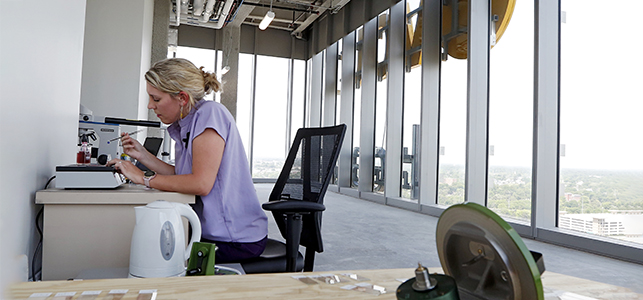
Why this is good news for allergy sufferers in Central Virginia
Ah-choo is common sound in Richmond. Makes sense since we’re ranked the eighth most challenging city in the country to live with seasonal allergies. This is according to the Asthma and Allergy Foundation of America.
While it’s hard to escape the pollen, knowing when counts are particularly high, or low, can help allergy sufferers plan daily activities to mitigate seasonal allergy symptoms. Staying on top of this information has gotten easier now that CHoR is an official pollen counting station certified by the National Allergy Bureau and run by our allergy and immunology team.
Dr. Wei Zhao, professor and chief of allergy and immunology at CHoR, explains the pollen counting process and how the information will be helpful.
How will CHoR being a pollen counting station help our patients and the Central Virginia community?
There are more than 80 pollen counting stations throughout North America but, until now, the closest one to Richmond was in Washington, D.C. The air sampling in Washington, D.C. is likely to have large variability from our air space here in Richmond. It is important that we’re correctly tracking the start, peak and end of pollen season to aid in treatment plans for our patients. It’s also important that we are accurately identifying the pollen grains in our area so we can have the most relevant environmental testing and targeted immunotherapy.
Where is our pollen counting station located?
Our counting station is located on top of VCU Health’s Adult Outpatient Pavilion, just a few blocks from the Children’s Tower. We scoped out multiple different areas to find one that didn’t have any obstructions that would interfere with the natural air flow and skew the sampling. We couldn’t use the top of the Children’s Tower due to our helipad and the up-wind obstructions caused by incoming helicopters.
How does the pollen collection and counting process work?
An air sampler continuously collects a sample 24/7 by flowing freely with the natural movement of the wind. A member of our allergy and immunology team goes onto the roof to unload the sampling head once a week. Then we mount the sample onto a microscope slide, stain it and look at it under the microscope. We’re able to identify different pollen grains by their size and other key features. We count each type and report the data into a public database operated by the National Allergy Bureau. The public can access the data by setting up an account – and can even request an email notification when updated readings are available.
Pediatric allergy and immunology nurse practitioner, Jessica Hess, explains the pollen counting process
How long has this been in the works?
We started the discussion regarding the pollen counting station in February 2024. We identified a champion within our department, Jessica Hess, CPNP, to be our designated pollen counter. She attended in-depth courses, then had to complete a series of testing which was graded by experts in pollen and fungal spore identification. We then obtained all the necessary equipment and worked with VCU Plant Operations to have it installed on the roof.
Are there future plans to continue helping Central Virginians who suffer from seasonal allergies?
Becoming a certified pollen counting station allows us to better guide management of allergic conditions and conduct further research. There is great potential for creating immeasurable impacts to our community’s health and overall well-being. Looking ahead, our goals include:
- Creating a local pollen calendar reflecting the true start, peak and end to pollen season in the Richmond area. This will be a long-term initiative as we’ll need approximately 3 years' worth of data to correlate trends.
- Obtaining our fungal spore counting certification, which we will be looking into over the next 5-10 years. This will take additional certification and time under the microscope to identify.
- Better understanding climate change as it relates to allergies. Our climate is changing rapidly, resulting in shifts in precipitation patterns, more frost-free days, warmer seasonal air temperatures and more carbon dioxide in the atmosphere which will affect how our seasonal pollen interacts in the environment.
- Collaborating with other subspecialties for broader research opportunities.
